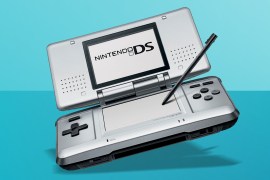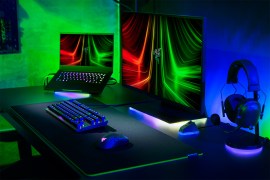Atari 2600+ review: slots of fun or gaming relic?
Modern remake of a classic console is all about the retro experience
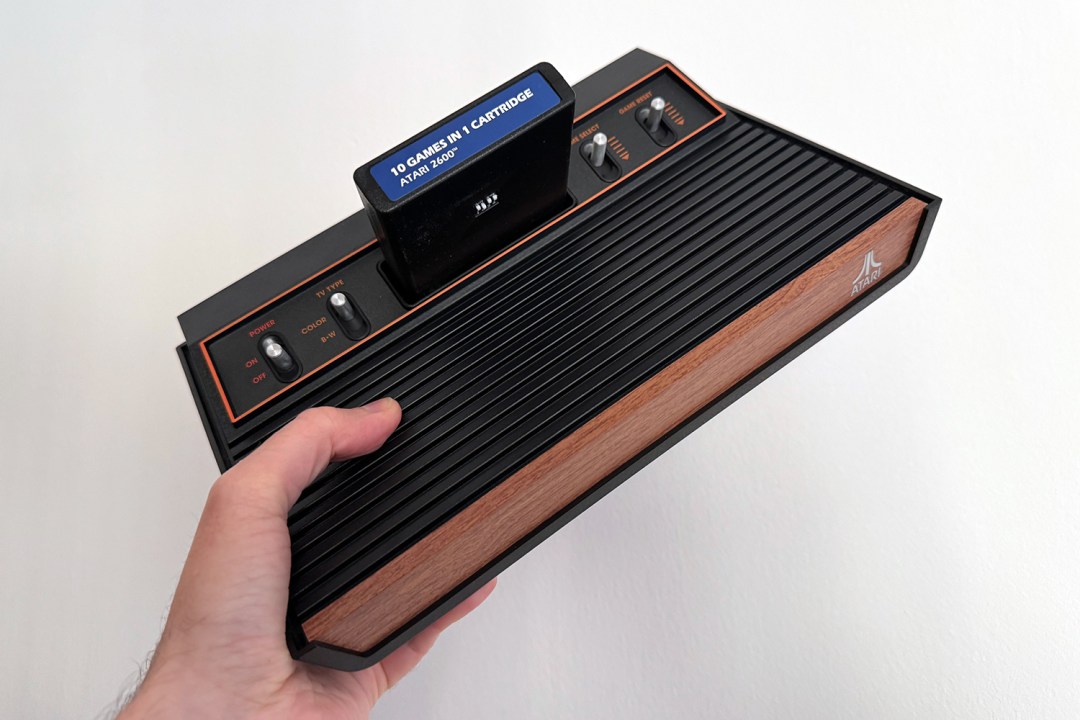
Stuff Verdict
A frequently joyful replica of a classic console that’s a bit too faithful for its own good. And it’s hard to work out who it’s for.
Pros
- Looks the part
- Solid Atari 2600 emulation
- Supports authentic controllers
- Runs (most) old carts
Cons
- Some issues with PAL carts
- Only one bundled joystick…
- Barely any settings and no save states
- Too few new available cartridges
Introduction
It would be easy to dismiss the Atari 2600+ as the latest ancient games system to be put through a hot wash and resurrected to prod your nostalgia nubbin. But unlike the miniaturised NES, SNES, Mega Drive, PlayStation, C64 or Amiga (among others), the 2600+ isn’t that small. Moreover, despite costing $130/£100, it doesn’t include built-in games either. Instead, you load original cartridges. Bonkers.
This console, then, is more reissue than remake – although in reality it’s a bit of both. And truth be told, even as I write this, I’m still confused about who this console is for. Let’s hope I figure that out by the end of the review, eh?
How we test gaming hardware
All games consoles and gaming hardware tested on Stuff are put through their paces with days’ worth of play time. We use our years of testing experience to judge areas such as build quality, software experience, battery life and other features. Manufacturers have no visibility on reviews before they appear online, and we never accept payment to feature products.
Find out more about how we test and rate products.
Design & build: Woody, you know it

Good news for old people who still reckon Pitfall! is the pinnacle of gaming: the Atari 2600+ looks just like the ‘Woody’ original. It has the same woodgrain effect. The same angles and design that scream 1970s. Even the same number of stripes on the plastic grille.
Up top, there’s a fully working cartridge slot and chunky switches that pleasingly go THONK when you move them. Around back, there are some concessions to modernity: HDMI output for your TV and USB-C for power. But not USB-C for controllers. Instead, you get two DB9 ports, designed for original Atari-compatible joysticks.
As someone who once had a small pile of such controllers, this made me grin. I imagine if you’re not of that vintage and have rocked up through sheer curiosity, your facial expression might be very different.
Controllers: The joy of sticks
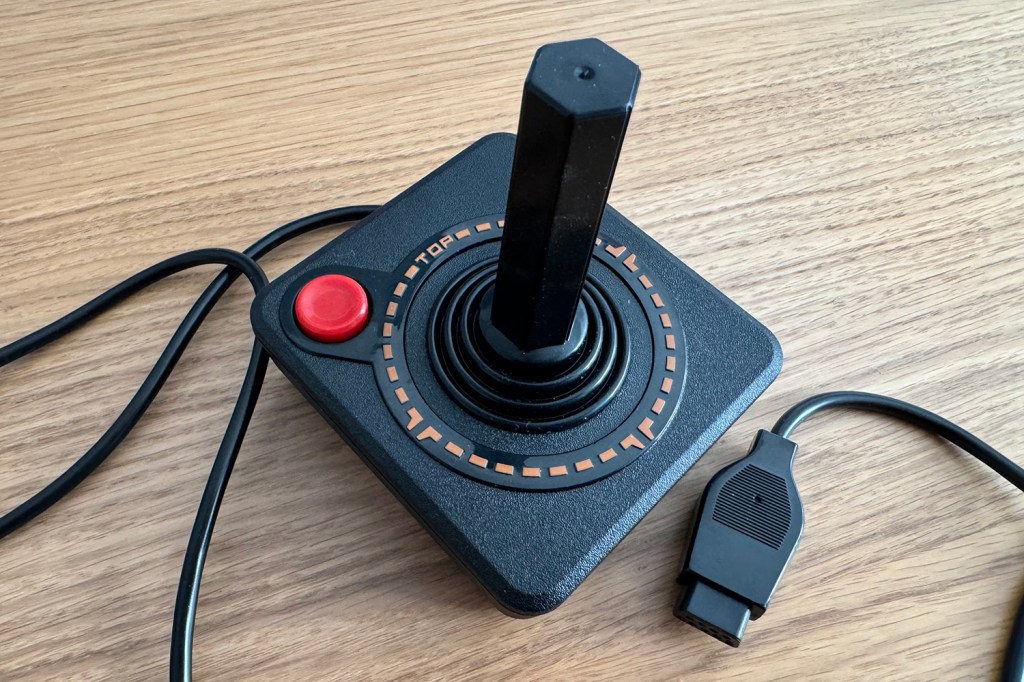
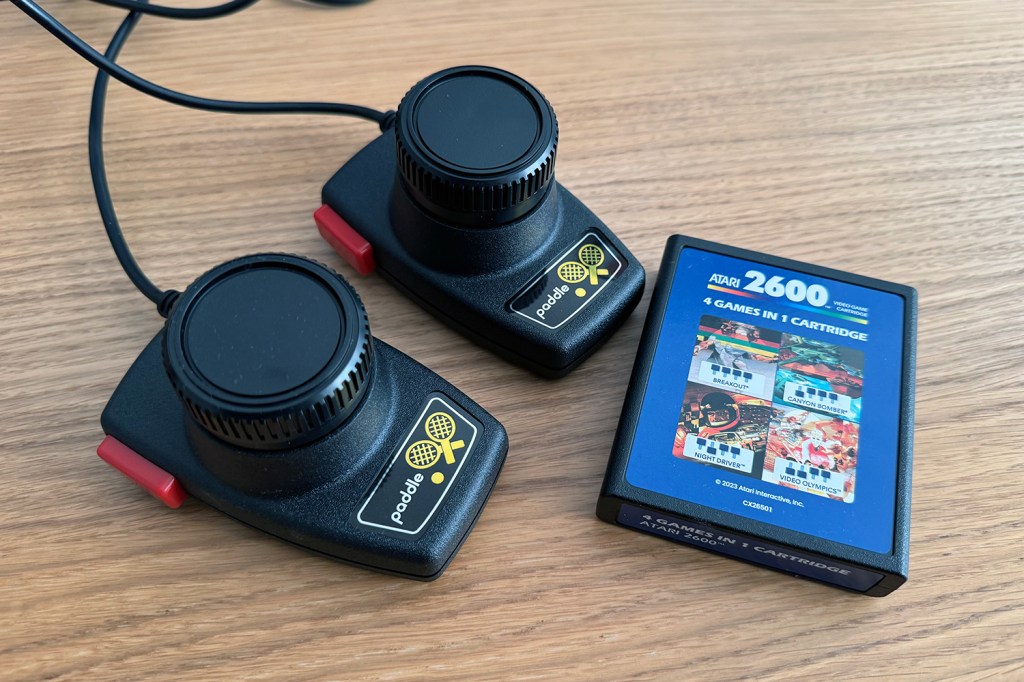
Let’s talk controllers. Atari doesn’t expect you to root around dusty boxes in attics and basements – you get an old-school CX40+ bundled with the console. This joystick is as basic, stiff, unforgiving and bare-bones as I remembered. However, it is authentic, responsive and well suited to Atari 2600 games.
The lead is a bit longer than the original, but still only 1.5m (about 60in). While kids might be fine with their noses pressed to a screen, I doubt older folks with creaking knees will be keen to sit that close to their telly. So although this faithfully recreates another aspect of the original Atari 2600 experience, that experience irks when you fancy some lean-back gaming.
Should the CX40+ not suit for other reasons (ie hand cramp), there are potential alternatives. If you have an ancient compatible controller, it might work. My Euromax Zip Stik felt like blessed relief when I plugged it in and started playing. Other folks have had luck with various C64 and Master System controllers – and Mega Drive/Genesis ones with an adapter.
I was also sent a pair of paddles along with the Atari 2600+ to review, which come with a four-game cartridge – a bundle that costs $40/£30. These feel great and are a superb way to play Breakout, Video Olympics (Pong, basically) and the psychotic Night Driver. (The cart also includes the rubbish Canyon Bomber, where all two people do is prod buttons. Pfft.)
Games: Plug and pray

If you prefer sticking with a joystick, Atari bundles a 10-in-1 cart with the console. Endearingly/annoyingly (depending on your viewpoint), you don’t choose games via a menu. Instead, you flip physical (and tiny) dip-switches on the cartridge itself to pick your game. At this point in the review, I decided the Atari 2600+ couldn’t be any more tactile and analogue, short of revealing it was in fact powered by clockwork.
But are the included games objectively any good in Space Year 2023? I think so. Yars’ Revenge is a compelling arcade shooter. Dodge ’Em is an exhilarating risk vs reward ‘endless chicken’. The pioneering Adventure remains fun for speed runs. But do be mindful even these greats are chunkier than Lego when up on the screen. Also, some of the included games are… less good. For example, Combat requires two players – but there’s only one CX40+ in the box; and Video Pinball has no business getting yet another airing.
To play anything else, you’ll need to buy more cartridges. Atari made two available worldwide for its console’s debut: an excellent take on Berzerk and contemporary platformer Mr. Run and Jump. But each costs a whopping $30/£25, and you don’t even get a paper manual. (Go online for instructions.) I think Atari should have released more compilations at launch – $30/£25 for ten Activision classics, say, would have been a barg.
Another option is sourcing decades-old cartridges and playing an exciting game of Will It Work? Of three Atari 2600 carts I purchased, two did (Space Invaders and Battlezone) and one (Solaris) very much did not. After a clean, it sort of worked, but randomly reset the console. But then it’s over 35 years old. It’s a bit much to expect every cartridge you try to work after all that time.
Performance: Semi-instant gratification
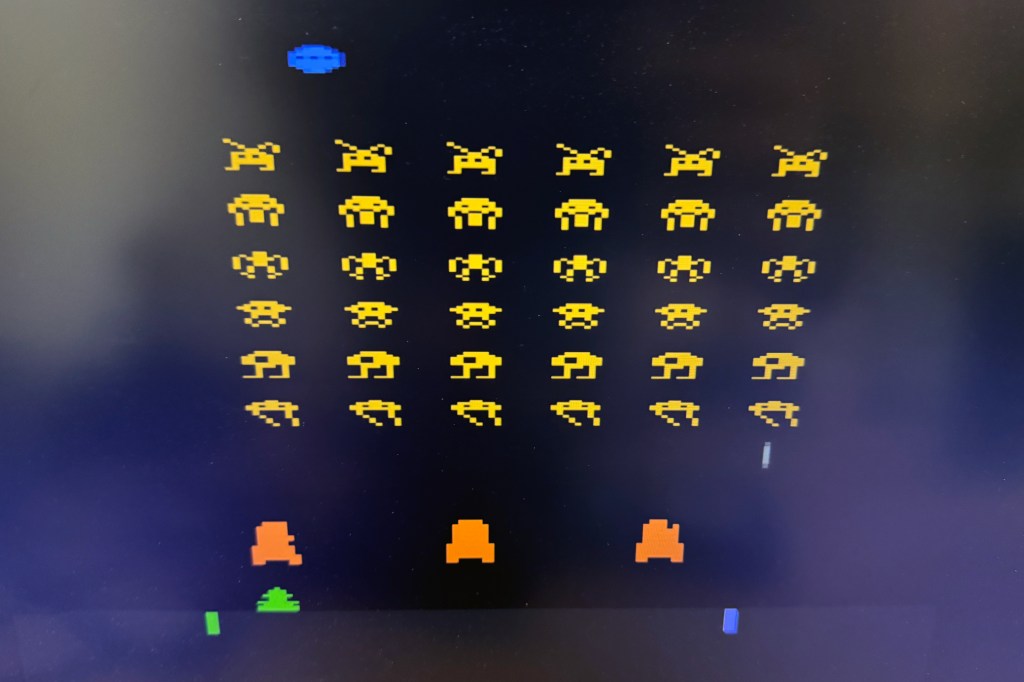
The Atari 2600+ is an oddball. Inside is a small board, most of which is dedicated to connectivity. The main PCB is a tiny Pi-ish thing. Every time you plug in a cart, the console dumps the ROM and squirts it to an emulator. This takes five to ten seconds, in stark contrast to the immediacy of the original 1970s console. But, honestly, that’s faster than most modern consoles get you to a game, and so it didn’t unduly bother me.
From what I can gather from an awful lot of forum posts, videos and direct feedback, most Atari 2600 games work well. Quite a few Atari 7800 games do not. (Surprise! This console runs 7800 games too.) There’s also discrepancy between the official compatibility list and reality, based on whether you use NTSC or PAL carts. (Some PAL games have minor issues.) I’d strongly recommend browsing AtariAge before sourcing new games.
So much for absolute authenticity, then. But Atari did tell me compatibility issues are already being worked on and will be addressed in an update. Moreover, when you do get something on the screen, the experience is solid. I didn’t notice any lag nor any glitches with the games I tried, bar when the physical cartridge had a problem.
However, it’s worth noting Atari’s dedication to a fully retro experience means there’s no space for save states and visual filters. The only setting for how games look is a switch that toggles output between 4:3 and 16:9 – the latter of which, when activated, will have you instantly removed from every dedicated retro gamer’s Christmas card list.
Atari 2600+ verdict

So have I figured out who the Atari 2600+ is for at this review reaches its conclusion? Sort of. And it’s quite niche. This console is for existing or wannabe collectors of Atari 2600 and/or 7800 cartridges, who want a hassle-free way to play them on a modern TV. And possibly analogue fetishists, who want to flick buttons and switches, and are offended by digital downloads, user-friendly menus, and wireless controllers. It’s for people who prize faithful recreations of old kit and tactile experiences. And who don’t mind getting up off the sofa every time they want to swap a game or change an important setting.
For the outlay, the console represents reasonable value, as does the paddles bundle, but the individual games are too wallet-punchy for my liking. And if you’re a casual fan who’s merely Atari-curious, there are better options. The wonderful Atari 50 compilation for PC and modern consoles costs the same as one new Atari 2600+ cart, yet nets you a slew of superb games for the Atari 2600 and six other systems. Or if you want something mini-consoleish, the latest Atari Flashback costs less than the 2600+ but bundles 110 games.
Personally, I’d pick the Atari 2600+ over the Flashback any day, despite its drawbacks. It feels like a labour of love, rather than a cheap impulse purchase. But Atari needs to take a leaf out of the Evercade’s book and prove its new console has a future by better supporting it. Otherwise this miniaturised remake of a groundbreaking console itself risks rapidly shifting from interesting novelty to dust collector to basement resident.
Stuff Says…
A frequently joyful replica of a classic console that’s a bit too faithful for its own good. And it’s hard to work out who it’s for.
Pros
Looks the part
Solid Atari 2600 emulation
Supports authentic controllers
Runs (most) old carts
Cons
Some issues with PAL carts
Only one bundled joystick…
Barely any settings and no save states
Too few new available cartridges
Atari 2600+ technical specifications
| Processor | Rockchip 3128 |
| RAM | 256MB DDR3 |
| Connectivity | HDMI, USB-C (power), 2x DB9 |
| Dimensions | 106x71x28mm (10.6×7.1×2.8in) |
| Weight | 709g (1lb 9oz) |

